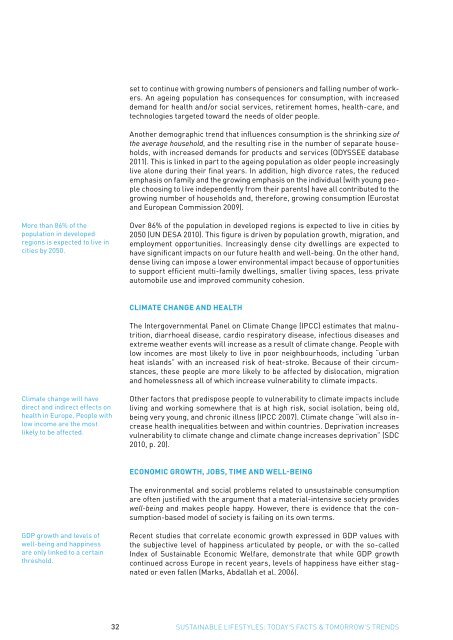today's facts & tomorrow's trends - SPREAD Sustainable Lifestyles ...
today's facts & tomorrow's trends - SPREAD Sustainable Lifestyles ...
today's facts & tomorrow's trends - SPREAD Sustainable Lifestyles ...
Create successful ePaper yourself
Turn your PDF publications into a flip-book with our unique Google optimized e-Paper software.
set to continue with growing numbers of pensioners and falling number of workers.<br />
An ageing population has consequences for consumption, with increased<br />
demand for health and/or social services, retirement homes, health-care, and<br />
technologies targeted toward the needs of older people.<br />
Another demographic trend that influences consumption is the shrinking size of<br />
the average household, and the resulting rise in the number of separate households,<br />
with increased demands for products and services (ODYSSEE database<br />
2011). This is linked in part to the ageing population as older people increasingly<br />
live alone during their final years. In addition, high divorce rates, the reduced<br />
emphasis on family and the growing emphasis on the individual (with young people<br />
choosing to live independently from their parents) have all contributed to the<br />
growing number of households and, therefore, growing consumption (Eurostat<br />
and European Commission 2009).<br />
More than 86% of the<br />
population in developed<br />
regions is expected to live in<br />
cities by 2050.<br />
Over 86% of the population in developed regions is expected to live in cities by<br />
2050 (UN DESA 2010). This figure is driven by population growth, migration, and<br />
employment opportunities. Increasingly dense city dwellings are expected to<br />
have significant impacts on our future health and well-being. On the other hand,<br />
dense living can impose a lower environmental impact because of opportunities<br />
to support efficient multi-family dwellings, smaller living spaces, less private<br />
automobile use and improved community cohesion.<br />
Climate change and health<br />
The Intergovernmental Panel on Climate Change (IPCC) estimates that malnutrition,<br />
diarrhoeal disease, cardio respiratory disease, infectious diseases and<br />
extreme weather events will increase as a result of climate change. People with<br />
low incomes are most likely to live in poor neighbourhoods, including “urban<br />
heat islands” with an increased risk of heat-stroke. Because of their circumstances,<br />
these people are more likely to be affected by dislocation, migration<br />
and homelessness all of which increase vulnerability to climate impacts.<br />
Climate change will have<br />
direct and indirect effects on<br />
health in Europe. People with<br />
low income are the most<br />
likely to be affected.<br />
Other factors that predispose people to vulnerability to climate impacts include<br />
living and working somewhere that is at high risk, social isolation, being old,<br />
being very young, and chronic illness (IPCC 2007). Climate change “will also increase<br />
health inequalities between and within countries. Deprivation increases<br />
vulnerability to climate change and climate change increases deprivation” (SDC<br />
2010, p. 20).<br />
Economic growth, jobs, time and well-being<br />
The environmental and social problems related to unsustainable consumption<br />
are often justified with the argument that a material-intensive society provides<br />
well-being and makes people happy. However, there is evidence that the consumption-based<br />
model of society is failing on its own terms.<br />
GDP growth and levels of<br />
well-being and happiness<br />
are only linked to a certain<br />
threshold.<br />
Recent studies that correlate economic growth expressed in GDP values with<br />
the subjective level of happiness articulated by people, or with the so-called<br />
Index of <strong>Sustainable</strong> Economic Welfare, demonstrate that while GDP growth<br />
continued across Europe in recent years, levels of happiness have either stagnated<br />
or even fallen (Marks, Abdallah et al. 2006).<br />
32<br />
SUSTAINABLE LIFESTYLES: TODAY’S FACTS & TOMORROW’S TRENDS
















